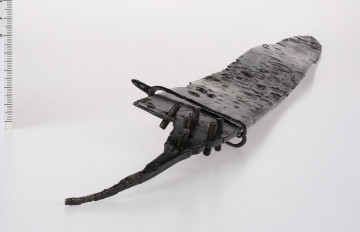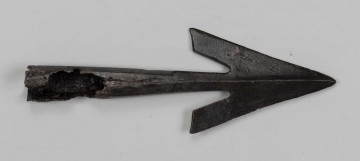
Arrowhead
National Museum in Lublin
Part of the collection: Set of archaeological relics found in the Lublin Region
The iron javelin spearhead is one of several surviving elements of a pole weapon discovered in a cremation grave dating to the early 3rd century AD. The discovery of the grave was made in 1959 by accident, during agricultural works. The artefacts found in 1960 were transferred to the Voivdship Heritage Protection Officer in Lublin, and then to the Lublin Museum.
The grave was equipped with an iron sword with a copper inlay depicting Roman gods: Mars and Victoria, an umbo (top part of a shield) with a high blunt spike, two iron spurs, two iron javelin spearheads ritually bent and broken, a tok (probably a spear shaft fitting), and a bent spearhead with a silver inlay on the leaf and sleeve in the form of symbolic signs and lines.
The javelin spearhead is one of two nearly identical specimens. Pairs of spearheads are a common piece of weaponry discovered in the graves of warriors from the first centuries AD, i.e. the early Roman period. They can be identified with weapons described by Tacitus in Germania as framea.
The ritually bent spearhead was found in the grave of a warrior of the Przeworsk culture. It is possible that the weapon belonged to a warrior who was a member of the elite of this culture, identified with the Vandals, who inhabited the Lublin region in the first centuries AD.
Author / creator
Dimensions
cały obiekt: height: 30,7 cm
Object type
weapon
Technique
forging
Material
iron
Creation time / dating
Creation / finding place
Owner
The National Museum in Lublin
Identification number
Location / status

National Museum in Lublin

National Museum in Lublin

National Museum in Lublin
DISCOVER this TOPIC
Museum of King Jan III's Palace at Wilanów
DISCOVER this PATH
Educational path